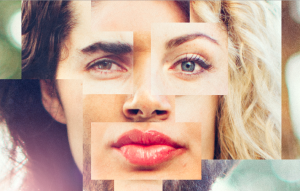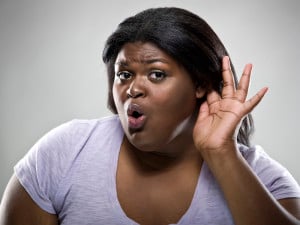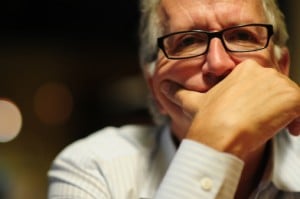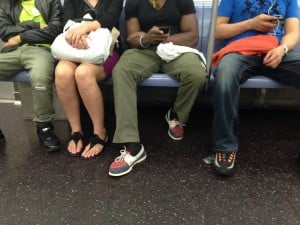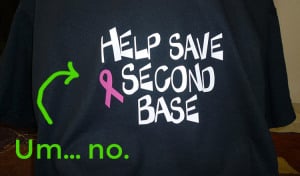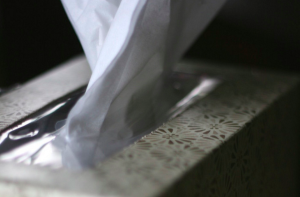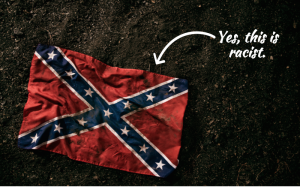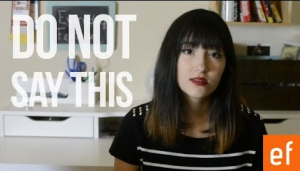Representation – while it should never be the sole goal of a group, it is an important stepping-stone on the way to equity.
The bodies that are showcased in the media have massive impacts on how individuals think and feel about themselves and how they are perceived and treated by others. So, it is critical that we critically approach the ways in which certain bodies and identities are represented in the media.
As a non-binary trans person, the representation of non-binary folks has been at the forefront of my mind recently.
Since there is such a lack of representation of non-binary folks in the media, society tends to latch on to whatever scraps are thrown our way without fully problematizing what those scraps are.
With Ruby Rose in Orange Is the New Black and high-profile runways featuring “androgynous” looks, it has become very clear to many what our community has felt for a long time: the definition of androgynous is seriously narrow and extremely exclusionary.
Not only that, but this narrow view of androgyny works to reinforce mainstream beauty standards, not push against them.
As the amazing poetry duo DarkMatter has said in the past, “we are not getting better, we are getting bitter,” and the only way to change that is by putting a serious critical lens up to what is being showcased as the end all be all of androgyny.
Here are four problematic things about the way androgyny is depicted in mainstream and LGBTQIA+ media, and why they are both harmful and inaccurate.
1. White Is Too Frequently Depicted As Default
The never-ending sea of whiteness is a problem in almost every aspect of our society. We have reached a point, culturally, where the “default” body is always white.
This means that, unless you are specifically addressing race, the bodies chosen to represent other minority and dominant groups, alike, are almost always white.
This has lead to a cultural understanding of androgyny that is centered in whiteness. This type of representation conjures up an extremely pale image of what it means to be gender-non-conforming (GNC) – which, despite what most runways and television shows convey, is much more holistic than just “aesthetics.”
By centering androgyny in whiteness, you celebrate and advocate for white GNC folks at the expense of GNC folks of color.
This means that white GNC folks are being held up as the default, all the while erasing and ignoring the existence of GNC folks of color.
Not only is this straight up white supremacy, but it erases and ignores all the work GNC folks of color have done for our community.
In fact, almost everything, from the clothes, the posturing, and the language of the queer and trans community comes from folks of color, specifically black folks.
For example: voguing, “realness,” “slay,” and “boi” all came out of black gender-non-conformity, specifically the ball scene. But, like most things, the whitest parts of these groups have taken these cultural signifiers over time and branded them as their own.
So, this focus on the whitest bodies, when it comes to gender non-conformity, not only leaves out folks of color, but is also rooted in the stealing and appropriation of black culture.
On top of stealing black culture, I have seen a lot of white non-binary folks using identities from closed cultures to identify themselves. Again, the whiteness of androgyny is built upon the backs of folks of color. For example, terms like “two-spirit” should never be used by those who do not belong to the Native communities from which this term comes.
White non-binary and gender non-conforming folks, like myself, need to acknowledge that the gender binary is a tool of white supremacy and colonial violence.
And while we too suffer from cissexism and binarism, we do not face the added violence of white supremacy that our non-binary and gender non-conforming siblings of color face.
In order to truly break down systematic cissexism and binarism, white non-binary and gender non-conforming folks need to realize that we, too, are complicit in white supremacy and that we need to make sure that we are not perpetuating this violence through the ways in which we articulate our identities.
And a major step in combating this violence is using our white privilege to amplify the voices of people of color in our community and a big part of the amplification is fighting for a much less white washed mainstream representation of these identities.
2. Thinness Is Code for Gender Neutrality
Like whiteness, thinness is something that is pervasive throughout GNC representation.
In fact, being thin is a major part of this mainstream androgynous aesthetic, especially since most mainstream representation of androgyny is actually the fashion industry – not the trans community.
Since the fashion industry boils androgyny down to the clothes on your back, fuller bodied gender-non-conforming folks are immediately pushed out of this mainstream visibility.
We are also conditioned to see androgyny as something masculine-centered (something I will get to in a bit) and our society tends to deem fat bodies as, not always more feminine, but definitely less masculine.
I think this is perfectly articulated by my search for “gender-neutral clothing” on the internet.
The first website that comes up is Wild Fang, a website that self-describes as “gender-neutral.” However, the store itself looks like the men’s section of ASOS being modeled by mostly white, always thin folks who appear to be CAFAB (coercively assigned female at birth).
On this site, not only was every item of clothing modeled on a thin person, but the sizes only go up to an XL in shirts and dresses and a 32 waist in pants (seriously?), making this site accessible only to those who are masculine centered in their androgyny and thin enough to fit into their restrictive sizes.
The image we get of androgyny is so much wrapped up in gaunt faces, flat chests, and narrow hips.
It has truly become a “look” – a “look” that relies heavily on the aesthetics of thinner more angular bodies.
And while I can’t speak for everyone, I can imagine that, with the ideas of androgyny we are fed on a daily basis, when the average person is asked to picture an androgynous person, thinness becomes a major part of that mental image. And I would say that websites like Wild Fang do a great job of backing this assumption up.
This not only hurts bigger bodied non-binary and gender non-conforming folks, but, like most problematic aspects of androgyny, perpetuates harmful fatphobic ideology, while actively erasing and excluding so much of our community.
3. Masculinity Is Recognized as Being Genderless
It is a well-known fact among most feminists that men and masculinity are deemed “natural” and “neutral” in our patriarchal society (as is whiteness and thinness is in our fatphobic, white supremicist society).
Therefore, when people begin to uncritically conceptualize androgyny, they tend to always conceptualize it as masculine.
At first glance, you might disagree with me. You might think, “But Kris, of course men are gendered! Look at all this masculinity!” But all of that masculinity almost never gets read as “gendered.”
I would like to again bring up the website Wild Fang (sorry Wild Fang, y’all have some really cute flannel dresses, but you do a great job at illustrating my points here). This site claims to be gender neutral, but every single item of clothing is, in some way, borrowing from a traditionally masculine aesthetic. Flannels, beanies, baggy t-shirts – all deemed neutral and “genderless” because men and men’s fashion is seen as default, neutral, without gender.
It is the fashion industry equivalent of “Women’s Studies is Gender Studies, Men’s Studies is History.”
This is why almost every bit of GNC representation is of DFAB, masculine presenting folks. Androgyny is almost always centered around trans-masculine aesthetics, which not only reinforces the idea that masculinity is somehow devoid of gender, but it also erases all the trans-feminine non-binary folks.
If you need anymore proof that mainstream depictions of androgyny center masculinity and DFAB bodies, just google image search “androgyny” and gaze upon the sea of white cis women wearing suits.
4. Femininity Is Defaulted As ‘Other’
Dressing androgyny in masculinity does nothing but parade men and masculinity around as if they have no gender.
This not only lets masculine centered people off the hook for critically approaching gender and all of its political implications, but it reinforces the idea that women and femininity is “other.”
And this “otherness” is part of what puts trans women and trans feminine people in so much danger.
Throwing all of masculinity’s gender responsibilities onto femininity makes it appear nearly saturated with gender. This creates an idea that people cannot exist as femme while still holding a gender-neutral or non-binary identity.
This creates a space where AFAB, femme, non-binary people have their trans identities erased and where AMAB (assigned male at birth) folks are automatically viewed as binary trans women.
Consequently, AFAB folks are being told that they cannot be non-binary or androgynous if they are femme and AMAB people are being told that they simply aren’t trying hard enough to exists as cis-passing women (which is an entirely different very important conversation).
All of this leads to a vision of androgyny that denies the experiences and identities of femme non-binary people and focuses almost entirely on cis-women and AFAB trans masculine people.
This really boils down to the fact that many more cis folks can accept an AFAB person wanting to dress more masculinity. We are allowed to be tomboys, we can see ourselves as edgy fashion forward, and serious.
Our look is the marker of someone wanting to step up in the world, leave behind the frivolous nature of the feminine and step into the powerful suit or the grizzly and rebellious white V-neck and ripped jeans.
But, AMAB folks are not granted the same privilege when it comes to their gender exploration.
And while many GNC cis women and butch non-binary folks are certainty not exempt from ridicule, violence, and rejection, it is pretty clear that this shift away from femininity is not pathologized or stigmatized in the same way that moving away from the masculine is.
All of these things work together into a toxic paste of masculinity worship, the neutralizing of men’s gender, and violence towards AMAB folks and trans femmes.
***
Although I tend to present in a more femme way most of the time, when I throw on a loose pair of jeans and a t-shirt, I am the poster child for androgyny.
I have a thin frame, small chest, pale-ass face, and even some tattoos and piercings for good measure. When I was rocking a shaved head with blue cropped bangs, I was basically a caricature of my own identity.
But, mainstream ideas of androgyny impacted a lot of how I looked for so long. Since I am privileged enough to attain that aesthetic, I went for it.
I thought it was the only way I could achieve a “proper” non-binary look, even if it meant letting my favorite dresses rot in the closet.
Mainstream representation does not exist in a vacuum. The ways in which these identities get reproduced and articulated have the power to perpetuate all the nasty grit and grime of our society, even when it is done under the guise of trans representation.
And while I am more than happy that someone like Ruby Rose is out there talking about her experiences outside the gender-binary, we need more than just another white, thin, masculine-centered person speaking for our community. Anything less than that works to make the world less safe for non-binary and GNC folks, not more secure.
If you are interested in hearing some amazing non-binary voices that reach outside of these harmful narrow guidelines please check out the work of the amazing poetry duo I mentioned early, Darkmatter. And if you exist in places of privilege, use that privilege to boost more marginalized voices in your community.
[do_widget id=’text-101′]
Kris Nelson is a writer who runs a blog full of short queer-centric radical prose and a YouTube channel called The Whispering Witch, focused on uplifting guided meditations and relaxation videos. Kris also runs an online store by the name of SpellBoundTreasures, where they strive to bring magic into the world through crystal jewelry and herbal remedies. They can be contacted on Tumblr or at [email protected].
Search our 3000+ articles!
Read our articles about:
Our online racial justice training
Used by hundreds of universities, non-profits, and businesses.
Click to learn more
Most Read Articles
- « Previous
- 1
- …
- 30
- 31
- 32


